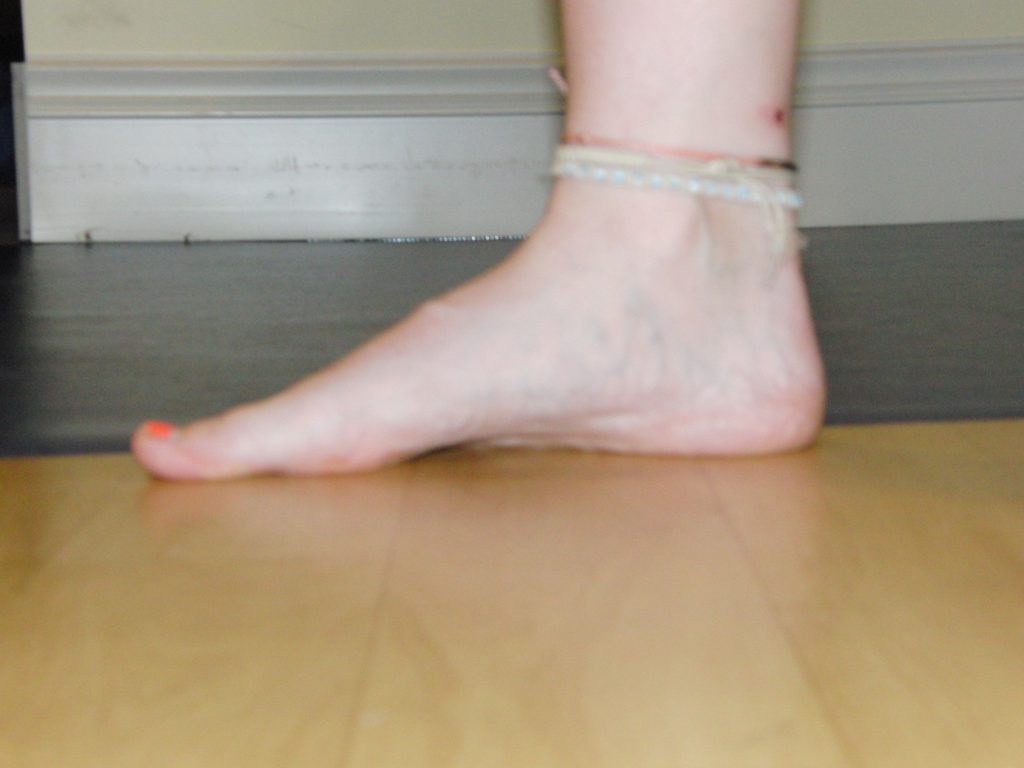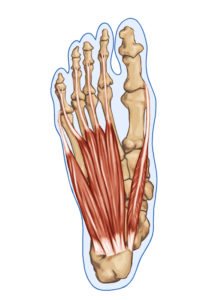Strengthening Exercises for Intrinsic Foot Muscles

Exercises to strengthen the foot are frequently used to treat injuries to foot, ankle, knee, hip and low back. Toe curl or toe scrunching exercises is not appropriate for strengthening the muscles intrinsic to the feet.
Muscles about the foot and ankle are described as either extrinsic muscles or intrinsic muscles. Extrinsic foot muscles have one attachment in the foot and the other attachment extrinsic to the foot up in the leg. Extrinsic foot muscles move the ankle and the foot. Intrinsic foot muscles have both attachments inside the foot. Intrinsic motions move one portion of the foot relative to other foot joints.

Intrinsic Plantar Flexor Muscles
Having strong intrinsic foot muscles is important. Muscles intrinsic to the foot are analogous to muscles intrinsic to the hand. Muscles intrinsic to the hand are responsible for fine motor activity such as typing, writing with pencil, and manipulating objects. The degree to which fine motor activity is needed in the feet is much less compared to the hand. However the intrinsic foot muscles still have an important role to play. Intrinsic foot muscles are used in controlling motion of the foot (pronation and supination); supporting the foot (arch support); fine tuning balance and stability; and providing stiff lever to facilitate propulsion.
Applying kinesiological principals of manual muscle testing clinicians purport to be able to differentiate movement occurring primarily as a result of intrinsic foot muscle activity from extrinsic foot muscle activity. The traditional exercise which is thought to strengthen the intrinsic foot muscles is “toe curls” using toes to gather a towel, picking up pencils, or marbles. A Czech Neurologist Vladimir Janda proposed a different exercise he called the “short foot exercise” to strengthen the intrinsic foot muscles. In order to see video examples of the two types of exercise search www.youtube.com for “toe curl exercises” and then search for “short foot exercise”.
A recent investigation using a measure of the electrical activity (electromyogram) of intrinsic foot muscles versus extrinsic foot muscles compared the toe curl exercise against the short foot exercise. The conclusion was the short foot exercise engages the intrinsic foot muscles to a greater degree than the toe curl exercise (Jung, DY 2011).
Description of “Short Foot” exercise for strengthening intrinsic foot muscles:
Sit with feet flat on ground, shoulder width apart. Lift toes off the ground, keep ball of feet on the ground. The action of lifting toes results in a rising of the arch of the foot. Slowly lower toes down to the ground while contracting the muscles in the arch to maintain a higher arch. Actively pull the big toe joint towards the heel shortening the foot. Make sure to keep the toes flat and straight avoid curling the toes. Maintain this high arch foot pose or posture and isometric contraction of the intrinsic foot muscles for a period of time (30 seconds).
After proficiency of achieving a high arch short foot position while sitting the exercise can be progressed to maintaining the higher arch posture when standing. While actively maintaining the high arch position short foot position with toes flat on ground pick one foot up and balance on the active foot. Do not let the foot/arch collapse. Maintain balance with good posture, for a period of time (10 seconds progressing to 30 seconds). Monitor to avoid gripping with toes and avoid tensing of the muscles in the calf. While maintaining “short foot position” various standing yoga poses can be performed while maintaining the high arch short foot posture.
Differentiation of big toe from lessor toes: Piano Toe Exercise
Demonstrating the ability to separate movement of the big toe from the lessor toes has been hypothesized as a way to activate the intrinsic foot muscles separate from the extrinsic foot muscles. This can be described as if you are playing a piano with the toes. While sitting or standing keeping the toes straight, spread the toes, and squeezes the toes together.
While sitting or standing lift the little toes off the ground while keeping the big toe on the ground. Then switch and lift big toe off the ground while keeping the little toes on the ground. Next perform the differentiated toe movements while maintaining the high arch short foot posture. If you can accomplish this with both feet, explore the short foot position with big toe on ground and toes off ground standing on one leg.
Damien Howell Physical Therapy – 804-647-9499 – Fax: 866-879-8591
At-Home, At Office, At Fitness Facility I come to you, I do home visits
Damien@damienhowellpt.com
